|
INSULIN ADMINISTRATION GUIDE

BEGINNER’S INSULIN ADMINISTRATION GUIDE FOR DOGS
THE INSULIN
|
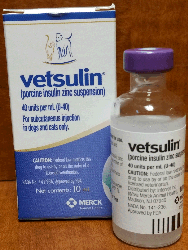
(original graphic by marvistavet.com)
|
Insulin is the injectable medication you will be using to control your diabetic dog’s blood sugar. When insulin therapy is first started, the optimal dose for your pet will be unknown and will have to be determined by trial and error.
Most dogs will need insulin injections twice a day, though occasionally a patient is found where a single dose is very long acting and once-a-day insulin works out. A dose will be selected based on what research has shown to be a good starting point and after a week or two, a glucose "curve" will be needed to map out the blood sugar levels over the day. This has traditionally been done in the hospital with blood glucose samplings done every 2 hours during the hospital's hours of operation. Alternatively, a continuous monitor such as a Libre Freestyle® (made for human use) can be implanted on the pet's skin and several curves can be obtained at home via a special reader or cell phone. The curve or curves will show if the insulin is lasting long enough and if the dose should be raised, lowered, or kept the same.
Alternatively, you can learn how to monitor your dog’s blood glucose levels yourself (click here for more information) but if you are a beginner you may want to master giving the injections before moving on to actually taking blood samples. If you become proficient at glucose sampling yourself, you can perform the curve at home and message the results to your veterinarian skipping the stress and expense of a hospital visit. This may not seem like a valuable technique to learn now that continuous monitors can be implanted but, going forward, you may want to be able to periodically (or even regularly) do glucose spot checks at home and for that you would need your own glucose meter and glucose strips.
|
|
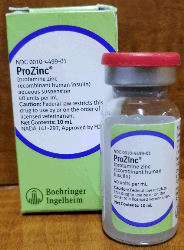 (original graphic by marvistavet.com) (original graphic by marvistavet.com)
|
There are several insulins used in the management of diabetic dogs. Vetsulin®, Humulin N® and Novalin N® are intermediate acting insulins. Vetsulin is of pork origin but pork and dog insulin are identical so Vetsulin (also called "Caninsulin" in other countries) is a veterinary product. Humulin N and Novalin N are human insulins available from human pharmacies. ProZinc® insulin is another veterinary insulin, while Glargine insulin and its variations are human products, all designed to last a bit longer than Vetsulin, Humulin N and Novalin N. Vetsulin, Humulin N, Novalin N and Glargine are available in both vials (where one draws insulin out with a syringe) and pens (where a dose is dialed in and a button is pressed to deliver the injection). ProZinc is available only in a vial. Human insulins are much more concentrated than veterinary insulins and require special syringes. Many people prefer the ease of the pen but it can be tricky if half unit doses are needed depending on which insulin pen we are talking about. |

(original graphic by marvistavet.com)
|
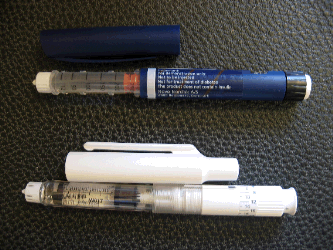
Insulin pens
(Photocredit: Public Domain image via Wikimedia Commons)
BE SURE YOU UNDERSTAND HOW MUCH INSULIN
YOU ARE SUPPOSED TO GIVE YOUR PET.
DO NOT CHANGE YOUR PET’S INSULIN DOSE
WITHOUT VETERINARY GUIDANCE.
STORING INSULIN
Insulin does not require refrigeration but since many insulins do not contain preservatives, it is best to refrigerate the product since we want it to last a couple of months without bacterial contamination. Human diabetics frequently do not refrigerate their insulin at all but, as human doses are substantially larger than animal doses, the vial or pen will not need to last nearly as long. The bottom line is that it is best to refrigerate the pen or vial to maximize the shelf life of the product. Unopened vials or pens should be stored in the refrigerator.
- Do not use insulin that is past its expiration date. In fact, it is a good idea to change to a fresh bottle every 6-8 weeks.
- Do not use insulin that has been frozen. Insulin is not normally frozen but accidents happen especially in smaller refrigerators.
- Do not expose insulin to direct light or heat.
SYRINGES FOR USE WITH VIALS
Human and veterinary insulins are made at different concentrations and thus each requires its own type of syringes for proper dosing. Insulin syringes are extremely small in diameter so that injection will not be painful. It is a rare patient that objects to insulin shots per se but some dogs resent being held still. It is crucial that that the injection goes into the dog rather than into the fur of the dog. The best area for injection is around the shoulders but, if possible, the area of the injection should be changed up with each injection from right to left for best insulin absorption.
|
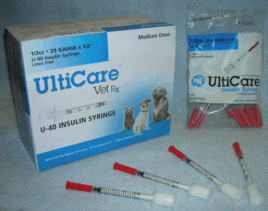
U-40 Insulin Syringes
(original graphic by marvistavet.com)
|
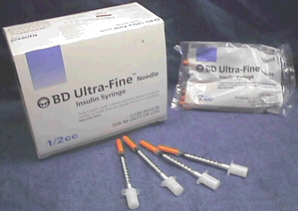
U-100 Insulin Syringes
(original graphic by marvistavet.com)
|
- Vetsulin is available at 40 units of insulin per cc and requires “U-40” syringes.
- Humulin N is available at 100 units of insulin per cc and requires “U-100” syringes.
Always be sure you have the correct syringes for your insulin.
Used syringes should be placed inside a thick plastic container (such as a liquid laundry detergent bottle or similar receptacle.). If the needle is enclosed such a container, the entire container can be closed up and disposed of in the regular trash at home. Special containers can be purchased for needle disposal or the used syringes can be returned to the veterinary hospital for disposal if you prefer.
|
SPECIAL RULES FOR CALIFORNIA
As of September 1st, 2008 it has been illegal to dispose of used sharp medical waste (syringes, needles, needle tips etc.) in the regular trash even if they are in a thick plastic container. You must instead return used sharp waste to a special disposal center or use a special “mail-in” sharps container. In California, medical wastes must go to special medical waste landfills.
For more information on what you are allowed to do: click here.
|
|
HOW TO GIVE THE INJECTIONS
|
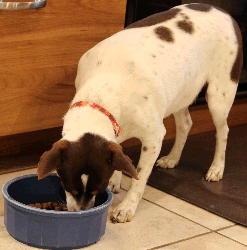 (Photocredit: Teri Ann Oursler, used with permission) (Photocredit: Teri Ann Oursler, used with permission)
|
First, feed your pet. A pet that has not eaten a normal meal but receives insulin may drop his or her blood sugar to a dangerous low level. If your pet is not eating, this could indicate a need for a check up with your veterinarian. After the pet has eaten, you are ready to give the injection. (Note, there is an exception to this rule. Novalin N appears to last longer if given prior to feeding. No one knows why this is and, as mentioned, this practice runs the risk of giving insulin to a pet that may not offset the insulin dose with calories).
Before drawing up the insulin, it is important to be sure that the insulin is properly mixed as some of it will settle on the bottom of the vial. The manufacturer of Vetsulin recommends simply shaking the bottle until the contents are uniformly milky. The manufacturers of other insulins recommend gently rolling the bottle in the palms of your hands or rocking it back and forth lightly to mix. The only product that should be shaken to mix is Vetsulin®.
|
|
When drawing up the insulin, always hold the bottle vertically to avoid unnecessary bubbles in the syringe. Since insulin is being given under the skin, the presence of bubbles is not an enormous problem (as it would be with an intravenous injection) but we still want to minimize the presence of bubbles. If you get bubbles in the syringe, flick the syringe with your fingers until the bubble rises to the top and then simply push the air out of the syringe with the plunger.
After you have the insulin dose ready in the syringe it is time to get your dog. Be sure you can trust your dog to hold reasonably still for the shot. Most dogs do not require a second person to hold them still but some dogs are very rambunctious and a helper is necessary. If you have such a pet but no helper, consider tying your dog’s leash short around a piece of furniture. (Use a slip knot in case of choking emergency.) Some dogs are very uncooperative and require a muzzle.
|
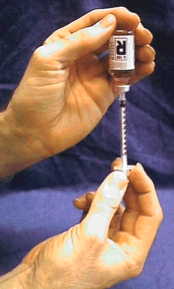
(original graphic by marvistavet.com)
|
|
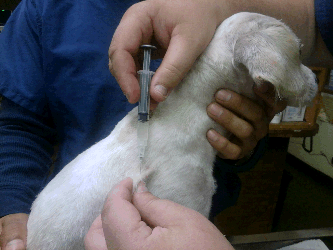
(original graphic by marvistavet.com)
|
Lift up a fold of skin ideally along the side of the body. This will create a small space for the needle. Insert the needle into this space and inject the insulin. Withdraw the syringe and needle when you are finished.
|
To view this information in a video format:
www.youtube.com/watch?v=dLGEw5psOhc
INSULIN BY PEN
An insulin pen is a gadget that allows precision insulin measurements and push button ease of administration. The arrangement is called a "pen" because it is shaped like a writing pen. A cartridge of insulin is snapped inside and a small needle tip is applied to the pen tip (a new tip should be used with each use). The dose is dialed in with accuracy up to the half unit (much more accurate than trying to "eyeball" tiny doses with a syringe). The pen is "primed" with a dose before it is used on the patient after which the needle is inserted through the pet's skin and a button at the top of the pen is pressed. The needle must stay in place at least 5 seconds to insure the full dose has been delivered. Most people find this method of insulin delivery easier than using syringes.
Most human insulins are available as pens but Vetsulin® is the only veterinary insulin available as a pen. Vetsulin pens are sold separately from their insulin cartridges. The cartridges should be stored upright in the refrigerator though the loaded pen may be stored in the refrigerator on its side. Most human insulin pens are disposable and cannot be reloaded.
Want more information on the Vetsulin VetPen®? Watch this video: https://www.youtube.com/watch?v=BE8_Zkp9tCw

Giving injections and becoming comfortable with needles may seem intimidating at first but you will most likely be surprised at how easy it quickly becomes. Managing a diabetic pet is definitely a project but can be a very rewarding one. If you have any questions or problems, remember your veterinarian's office is available for demonstrations or to answer your questions as they come up.

Page last updated: 4/12/02025
|